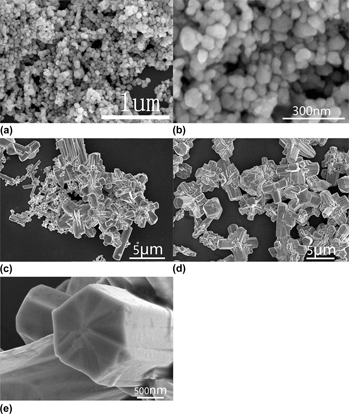Crossref Citations
This article has been cited by the following publications. This list is generated based on data provided by
Crossref.
Yang, Xiao
Luo, Juan
Zhou, Lei
Yang, Bo
Zuo, Xueqin
Li, Guang
Tang, Huaibao
Zhang, Haijun
Wu, Mingzai
Ma, Yongqing
Jin, Shaowei
Sun, Zhaoqi
and
Chen, Xiaoshuang
2014.
A novel Pt-free counter electrode for dye-sensitized solar cells: Nickel sulfide hollow spheres.
Materials Letters,
Vol. 136,
Issue. ,
p.
241.
Yang, Xiao
Zhou, Lei
Yang, Bo
Zuo, Xueqin
Li, Guang
Feng, A Li
Tang, Huaibao
Zhang, Haijun
Wu, Mingzai
Ma, Yongqing
Jin, Shaowei
Sun, Zhaoqi
and
Chen, Xiaoshuang
2014.
NiS Nanoparticles/CdS Nanocrystals Hybrids Materials as Counter Electrodes for Dye-Sensitized Solar Cells.
Journal of The Electrochemical Society,
Vol. 161,
Issue. 12,
p.
H711.
Zuo, Xue-Qin
Yang, Xiao
Zhou, Lei
Yang, Bo
Li, Guang
Tang, Huai-Bao
Zhang, Hai-Jun
Wu, Ming-Zai
Ma, Yong-Qing
and
Jin, Shao-Wei
2014.
Facile synthesis of Bi2S3–C composite microspheres as low-cost counter electrodes for dye-sensitized solar cells.
RSC Adv.,
Vol. 4,
Issue. 101,
p.
57412.
Theerthagiri, Jayaraman
Senthil, Arumugam Raja
Madhavan, Jagannathan
and
Maiyalagan, Thandavarayan
2015.
Recent Progress in Non‐Platinum Counter Electrode Materials for Dye‐Sensitized Solar Cells.
ChemElectroChem,
Vol. 2,
Issue. 7,
p.
928.
Shinde, Dipak V.
Patil, Supriya A.
Cho, Keumnam
Ahn, Do Young
Shrestha, Nabeen K.
Mane, Rajaram S.
Lee, Joong Kee
and
Han, Sung‐Hwan
2015.
Revisiting Metal Sulfide Semiconductors: A Solution‐Based General Protocol for Thin Film Formation, Hall Effect Measurement, and Application Prospects.
Advanced Functional Materials,
Vol. 25,
Issue. 36,
p.
5739.
Wang, Xiuwen
Batter, Buhe
Xie, Ying
Pan, Kai
Liao, Yongping
Lv, Chunmei
Li, Mingxia
Sui, Siyu
and
Fu, Honggang
2015.
Highly crystalline, small sized, monodisperse α-NiS nanocrystal ink as an efficient counter electrode for dye-sensitized solar cells.
Journal of Materials Chemistry A,
Vol. 3,
Issue. 31,
p.
15905.
Roffey, Anna
Hollingsworth, Nathan
Islam, Husn-Ubayda
Mercy, Maxime
Sankar, Gopinathan
Catlow, C. Richard A.
Hogarth, Graeme
and
de Leeuw, Nora H.
2016.
Phase control during the synthesis of nickel sulfide nanoparticles from dithiocarbamate precursors.
Nanoscale,
Vol. 8,
Issue. 21,
p.
11067.
Su, An-Lin
Lu, Man-Ning
Chang, Chin-Yu
Wei, Tzu-Chien
and
Lin, Jeng-Yu
2016.
Scalable Fabrication of Efficient NiCo2S4 Counter Electrodes for Dye-sensitized Solar Cells Using a Facile Solution Approach.
Electrochimica Acta,
Vol. 222,
Issue. ,
p.
1410.
Zhou, Xiao
Wang, Chen
Zhang, Yangliang
Fang, Wen
Hou, Yuzhi
Zhang, Chen
Wang, Xiaodong
and
Yun, Sining
2018.
Counter Electrodes for Dye‐sensitized and Perovskite Solar Cells.
p.
531.
Ahmed, Usman
Alizadeh, Mahdi
Rahim, Nasrudin Abd
Shahabuddin, Syed
Ahmed, Muhammad Shakeel
and
Pandey, A.K.
2018.
A comprehensive review on counter electrodes for dye sensitized solar cells: A special focus on Pt-TCO free counter electrodes.
Solar Energy,
Vol. 174,
Issue. ,
p.
1097.
Bhardwaj, Rekha
and
Jha, Ranjana
2020.
Trisodium citrate assisted morphology controlled synthesis of nickel sulphide nanoparticles with enhanced cyclic stability as carbonaceous free electrode material.
Materials Chemistry and Physics,
Vol. 255,
Issue. ,
p.
123581.
Bhardwaj, Rekha
Jha, Ranjana
Bhushan, Medha
and
Sharma, Reetu
2020.
Enhanced electrocatalytic activity of the solvothermally synthesized Mesoporous Rhombohedral nickel sulphide.
Materials Science in Semiconductor Processing,
Vol. 118,
Issue. ,
p.
105194.
Huang, Yi-June
Chen, Han-Ting
Ann, Shiuan-Bai
Li, Chun-Ting
and
Lee, Chuan-Pei
2020.
Nanostructures.
Chang, Chin-Yu
Anuratha, Krishnan Shanmugam
Lin, Ya-Han
Xiao, Yaoming
Hasin, Panitat
and
Lin, Jeng-Yu
2020.
Potential-reversal electrodeposited MoS2 thin film as an efficient electrocatalytic material for bifacial dye-sensitized solar cells.
Solar Energy,
Vol. 206,
Issue. ,
p.
163.
Zheng, Wei
and
Zhang, Shuyi
2020.
The effect of CuS counter electrode microtopography on the properties of quantum dot sensitized solar cells.
Inorganic Chemistry Communications,
Vol. 122,
Issue. ,
p.
108294.
Manikandan, Venkatachalam
Elancheran, Ramakrishnan
Revathi, Palanisamy
Suganya, Palani
and
Krishnasamy, Kuppusamy
2020.
Efficient photocatalytic degradation of crystal violet by using graphene oxide/nickel sulphide nanocomposites.
Bulletin of Materials Science,
Vol. 43,
Issue. 1,
Bhardwaj, Rekha
Jha, Ranjana
Bhushan, Medha
and
Sharma, Reetu
2020.
Comparative study of the electrochemical properties of mesoporous 1-D and 3-D nano- structured rhombohedral nickel sulfide in alkaline electrolytes.
Journal of Physics and Chemistry of Solids,
Vol. 144,
Issue. ,
p.
109503.
Bhardwaj, Rekha
Jha, Ranjana
and
Bhushan, Medha
2020.
Improved electrocatalytic performance with enlarged surface area and reduced bandgap of caterpillar and cabbage-like nickel sulphide nanostructures.
Applied Nanoscience,
Vol. 10,
Issue. 10,
p.
3757.
Nidhi
Nautiyal, Tashi
and
Das, Samaresh
2020.
Large-Scale Synthesis of Nickel Sulfide for Electronic Device Applications.
MRS Advances,
Vol. 5,
Issue. 52-53,
p.
2727.
Huang, Yi-June
and
Lee, Chuan-Pei
2021.
Solar Cells - Theory, Materials and Recent Advances.
